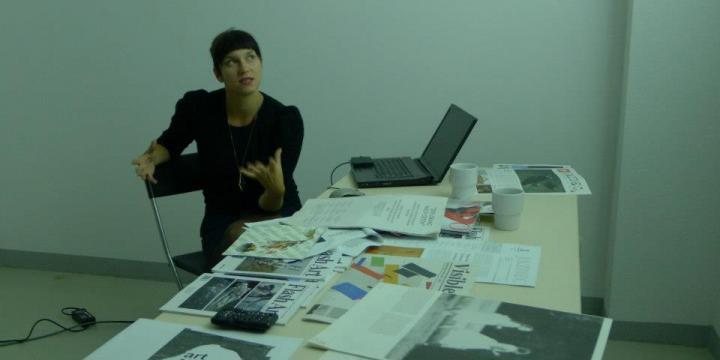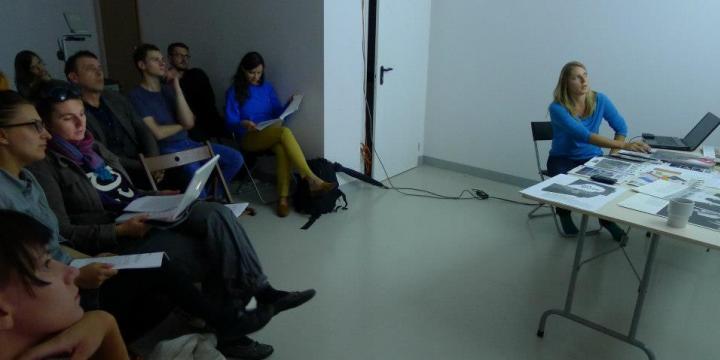August 31 / September1, 2012
Artists: Erik Binder, Andrea Kalinová, Michal Moravčík, Katarína Morháčová, Martin Piaček, Tomáš Rafa, Magda Stanová.
Curated by: Lýdia Pribišová
Ventilator is a two day immersion in the reality of contemporary Slovak art. The event consists of a discussion with Slovak artists and the curator about relevant themes in contemporary Slovak art and presentations of the artist’s works.
31.8. 2012
The curator Lýdia Pribišová will present an overview of contemporary Slovak art, as well as presenting Flash Art magazine’s Czech and Slovak Edition, of which she is an editor, together with other Slovak magazines dedicated to contemporary art, such as Jazdec, Vlna, Photoport and Profil.
During the evening, three Slovak artists with different programs will present their works:
Magda Stanová focused on the creative process, thetheory of photography, urban development and cartography and standardized behavior, which she transcribes in particular algorithms. The results of her investigations are often innovative forms of artist presentations, as visual essays, books and lectures.
Katarína Morháčová is an artist observing various forms of perfection and failure. Her research is based on analyses of the politicum of the body, knowledge, abilities and aesthetics. With the artists Jaro Varga and Dorota Kenderová, she is running a contemporary art gallery (non profit gallery HIT) and will reflect on her unique experiences in this field.
Tomáš Rafais exploring the thin line between patriotism and nationalism and keeps searching for any displays of racism and xenophobia. His research over the last three years led to a
video project set against the background of demonstration, blockade and protest footage, complete with the scenes of everyday life in Poland, the Czech Republic, Hungary and Slovakia.
1.9.2012
One of the central themes of this evening will be art inthepublic space, ahot issue in Slovakia. The artist Martin Piaček will present the activities of the association called Verejný podstavec („Public Plinth“), whose aim is to take a position on the difficulties in transforming public spaces in the countries of the former Eastern Bloc through artistic events. They will discuss progressive sculptural and artistic interventions in public spaces, as well as the various forms of art that can be seen in the streets and squares of Slovak cities. The artist Andrea Kalinová will discuss her public art project Abandoned(re)creation, organized in the spa resort of Trenčianske Teplice, as well as another of her projects where she works with the memory of place.
During both days, a survey of contemporary and early Slovak video art will be presented. The emblematic example of the first Slovak video art / experimental film is Lift by Vladimír Havrilla from 1974. During the communist regime, experiments with video were outside the official art scene, as with the film by Ľubomír ĎurčekentitledInformation...about Hands and People (1982), a metaphor for living in conditions of limited liberty.
After ‘Velvet Revolution’, like other areas of visual art, video art mainly focused on the body, its physical perception and sexual and gender identity, as can be seen in the videos of Anna Daučíková. After the beginning of the new millennium, social and political topics dealing with the power of institutions and media, their influence and manipulations gained prominence in Slovak art. Artists also started to observe the contradictions between the public and private spheres, and reflected upon the mechanisms of the contemporary art scene. The duo Anetta Mona Chisa and Lucia Tkáčová employ sarcasm and a defiantly anti-authoritarian attitude in their use of the techniques of displacement, sabotage and subversion, whilst questioning structures, systems of power and gender hierarchies (in the art world as well as within various political and social realities). The subject of Tomáš Rafa’s videosis the territory where art and political activism meet. The project entitled TheNew Nationalism in the Heart of Europepresents an archive of audiovisual material from the Visegrad region. Meanwhile, a social-introspective approach is characteristic of the work of Pavlína Fichta Čierna.
The idea of globalization in confrontation with the local context is the topic of two videos, Kill Folk and Apocalypse, made by the young artist Matúš Lányi in the Slovak countryside. Some of the artists, such as Lucia Nimcová and Erik Binder&Kunst Fu group, remember the past socialistic era with humour and irony and see an overlap into contemporary life. The artists Peter Rónai and Petra Feriancová use an autobiographical strategy in their videos. In the videos of Mira Gáberová, characterised by their theatricality and visual sensitivity, we can also see a light echo of the autobiography. The particular identity of the artist is the topic of the video documentation of Mr. BRA, the hybrid artistic identity created by Marek Kvetán and Richard Fajnor. In the videos of Matej Gavula and Milan Tittel, it is possible to see the influence of sculpture. Karol Pichler is focused on research dedicated to the possibilities of language, especially language games in their socio-philosophical context. He uses words from everyday language as material for the construction of his sophisticated message.




